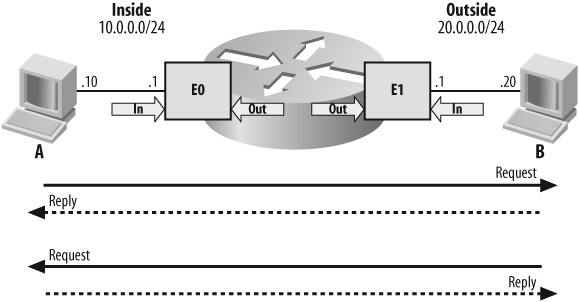Reflexive Access Lists
Reflexive access lists are dynamic filters that allow traffic based on the detection of traffic in the opposite direction. A simple example might be, "only allow telnet inbound if I initiate telnet outbound." When I first explain this to junior engineers, I often get a response similar to, "Doesn't it work that way anyway?" What confuses many people is the similarity of this feature to Port Address Translation (PAT). PAT only allows traffic inbound in response to outbound traffic originating on the network. This is due to the nature of PAT, in which a translation must be created for the traffic to pass. Reflexive access lists are much more powerful, and can be applied for different reasons.
Without PAT, a filter denies traffic without regard to other traffic. Consider the network in Figure 23-3. There are two hosts, A and B, connected through a router. The router has no access lists installed. Requests from host A to host B are answered, as are requests from host B to host A.

Figure 23-3. Simple network without ACLs
Say we want host A to be able to telnet to host B, but we don't want host B to be able to telnet to host A. If we apply a normal inbound access list to interface E1 on the router, we allow A to contact B, and prevent B from contacting A. Unfortunately, we also prevent B from replying to A. This limitation is shown in Figure 23-4.
Figure 23-4. Simple ...
Get Network Warrior now with the O’Reilly learning platform.
O’Reilly members experience books, live events, courses curated by job role, and more from O’Reilly and nearly 200 top publishers.

